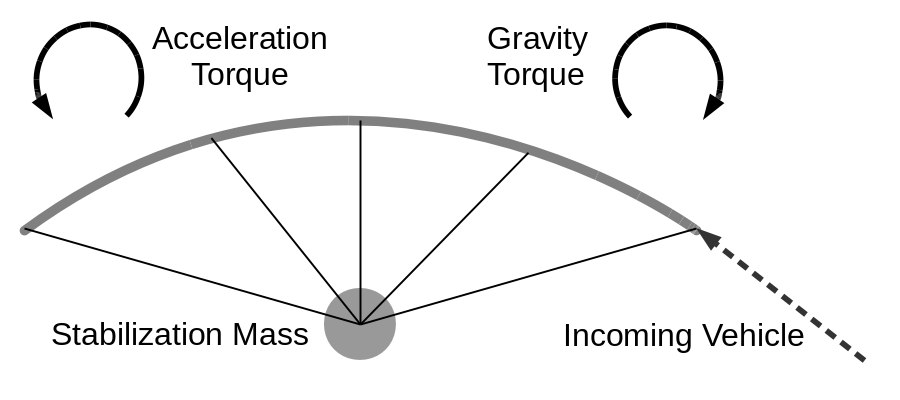Spaceport Torque
Roger Arnold's Spaceport captures incoming vehicles at perigee and accelerates them (while it decelerates). The vehicles arrive at a fraction of Spaceport orbital velocity and speed up to orbital velocity as the Spaceport slows down. The spaceport is moving slightly faster than circular orbital perigee in the beginning, and thus has a small net-upward acceleration, which we will ignore for now.
For ease of calculation, we will assume the spaceport has a perigee velocity v_p = 8000 m/s, the vehicle arrives at 4000 m/s, and gee at altitude is a = 10 m/s² (it is 8.9 m/s² at 310 km equatorial altitude, but let's keep this simple). The vehicle acceleration a_v within the spaceport is assumed to be 5 gees or 50 m/s², or 5 a. The spaceport is assumed symmetrical around its center of mass, extending a distance -L towards the inlet and +L towards the terminus. The vehicle mass is M and the spaceport mass is 2 m L >> M , with mass evenly distributed along its length.
The stopping distance is 2 L = {v_p/2}^2 / ( 2 a_v ) so L = {v_p}^2 / ( 16 a_v ) = {v_p}^2 / ( 80 a ) = 80 km. The total length and stopping distance is 2 L or 160 km. We will arbitrarily assign the datum at the center, so the entry point at t = 0 is x = -L . The velocity of the vehicle is v = 4000 + 50 t and the acceleration to 8000 m/s takes 80 seconds. The distance is the integral of this velocity added to -80000m, so d = -80000 + 4000 t + 25 t^2 .
The vehicle "lift acceleration" relative to the Spaceport at perigee is a_l = ( v^2 - {v_p}^2 )/ r_p where r_p is the Liftport perigee radius and v_p is the perigee velocity. A liftport begins vehicle capture at the perigee of a slightly elliptical orbit; the momentum transferred to the vehicle reduces Liftport apogee.
If vehicles descending from the Moon are the main source of makeup momentum, they may arrive weeks apart, as the Moon is in a slow inclined orbit that crosses the liftport orbital plane twice a month. Hence, the Liftport must store a lot of momentum, for weeks. Either the Liftport apogee (and perigee velocity) is somewhat high, or it must be massive, or capture rates are limited, or it must burn a lot of rocket propellant; all these options are inconvenient.
So; a_l is significant, and negative, until the vehicle accelerates to Liftport velocity v_p at the far end. The vehicle is constrained by the Liftport track, so instead of accelerating radially, it pushes radially on the track with a force of F = m a_l . The force is highest at the entry, half as high at the midpoint, and zero at the end. The vehicle spends 70% of its decelleration time on the second half of the track, but the radial force is much smaller. Obsessive readers are invited to derive v(t), {a_l}(t), and the distance down the track l(t), then compute the time integral of the torque on the liftport:
Torque = \int ~ m ~ {a_l}(t) ~ l(t) ~ dt . The integral which will be a fifth order polynomial in time. It will not be zero. The result will be a Liftport rotating away from the metastable "horizontal: orientation. Without immediate makeup thrust, it will keep turning and accelerating until it turns vertical, the keeps turning until it is backwards. Oops. If you don't believe this, please do the math yourself. It is better to find a better solution to the problem, and do the math for that, rather than determine exactly how inadequate this one is.
A better solution will look more complicated, but should help with three problems:
(1) zero net torque for vehicle capture, rotation to initial position when the vehicle stops
(2) provide positive stability, maximum at the desired pitch
(3) enhance lateral rigidity
. . . (3) requires some explanation. The Spaceport 2.0 description assumes couplers that adjust spacings to simulate an "einsteinium rigid" beam. If the perturbations are small, the coupler forces are small. However, keep in mind that the spaceport is quite long compared to its cross section; end torques are amplified at the couplers by the ratio of the length divided by the cross section. So, for a 80 km length and an 8 meter cross-section, the torques (and forces) at the center are multiplied by 10,000; if a 10 tonne vehicle vibrates at 10% of 5 gees, that is 50,000 Newtons wagging the ends, and 500 meganewtons at the couplers. To make a 1 millimeter length adjustment at the coupler with that force loading would require half a megajoule.
There's a reason why bridges are built with deep box frames, or suspension cables! Civil engineers may seem conservative, but they design structures that endure. Modern civil engineers are quite proficient in active damping; Japanese building engineers use piston actuators, and elevator movement(!), to help stabilize buildings in earthquakes.
|
Here's one possible configuration for Spaceport 2.1 with a hanging counterweight. The actual shape of the acceleration track will be optimized for minimizing stresses, and returning the Spaceport to a fixed stable position after a vehicle capture |

